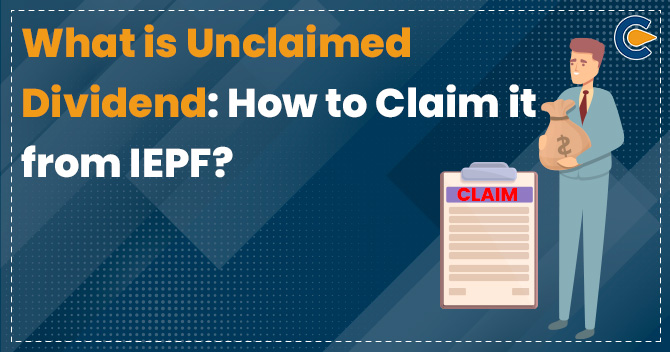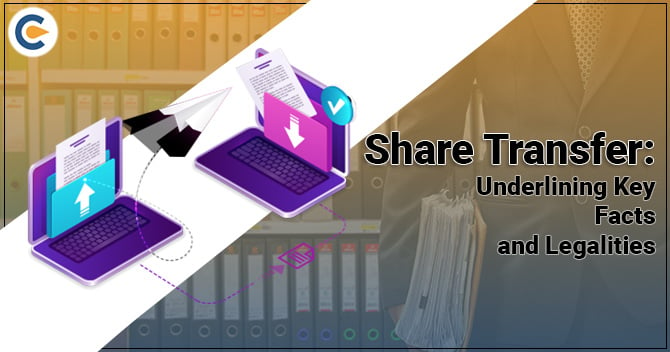Ministry of Corporate Affairs (MCA) notified Investor Education and Protection Fund Authority (Accounting, Audit, Transfer and Refund) Rules,2016, on 5th September 2016. As stated in this Rule, all companies must identify and provide details of their Unclaimed Dividend. This Rule talks about the transfer as well as a refund of such Dividends. In this blog, we will find the meaning of such Dividends and how to claim them from IEPF.
Meaning of Unclaimed Dividend
Share in profits made by a company distributed to every shareholder is termed a dividend. Quantity and quality of Dividends are decided and declared by the Board of Directors. There can be a final or interim Dividend, where the final is declared at the end of the financial year, and the Dividend declared on a quarterly or half-yearly basis is an interim Dividend. Dividends are paid on a pre-determined date; if declared Dividends are not paid until the pay-out date, it is called Unpaid Dividends.
A dividend paid by the company but not yet claimed or taken by the shareholder is called an Unclaimed Dividend. It is paid by the company on demand and is a liability for the company.
Difference between Unpaid and Unclaimed Dividends
Unclaimed and Unpaid Dividends are different from each other. If a company pays dividends to its shareholders, they should claim the paid dividends, so unclaimed dividends are recoded when a shareholder fails to claim its paid dividends. When a company fails to distribute dividends to shareholders after they have been announced, such dividends are called unpaid dividends. Such dividends are needed to be claimed by shareholders within 30 days of declaration of such dividends. Such dividends are kept in a separate unpaid dividend account.
Before 2000, all dividends were sent by cheque or dividend warrants. Most of the dividends become unclaimed due to some reasons such as change of address, incorrect address, etc. If dividends are not claimed for more than seven years, the company sends such dividends to Investor Education and Protection Fund account. And a shareholder has the right to claim such dividends from the IEPF at any given point of time.
Investor Education and Protection Fund
Investor Education and Protection Fund[1], commonly known as IEPF, is for the promotion of investors’ awareness and protection of their interests. It is utilised for the followings:
- Refund of unclaimed dividends, matured debentures, matured deposits, application money due for refund and interest.
- Promotion of investor’s education, protection and awareness
- Distribution of disgorged amount among eligible and identifiable applicants for shares or debentures, debenture-holders, shareholders or depositors who have suffered losses because of any other person, as per the court’s order of disgorgement
- Reimbursement of all legal expenses incurred in pursuing the class action suit under Sections 245 and 37 by members, debenture-holders or depositors as sanctioned by Tribunal
- Any other purpose incidental thereto, in accordance with such rules as prescribed, that the investor whose amounts as mentioned under Clauses (a)-(d) of Sub-section (2) of Section 205C is transferred/sent to Investor Education and Protection Fund (IEPF), after the period of seven years expires, according to the Companies Act, 1956, is entitled to get a refund from the Investor Education and Protection Fund in respect of such claims as per the rules made under this Section.
Investor Education and Protection Fund (IEPF) Authority
To administrate the Investor Education and Protection Fund (IEPF), the Government of India established Investor Education and Protection Fund Authority on 7th September 2016, under Section 125 of the Companies Act, 2013.
Apart from taking care of the Investor Education Protection Fund (IEPF) administration, the Authority is also entrusted with making refunds of shares, unclaimed dividends, matured deposits or debentures etc., to investors and also for promoting awareness among investors.
All such dividends that are transferred to the Investor Education and Protection Fund Authority after the expiry of seven years need to be recovered from it by the investors with the help of an expert.
Transfer of Unclaimed Dividends to IEPF
An amount transferred to the Unpaid Dividend Account of the Company, which is unpaid or unclaimed for more than Seven Years, is transferred along with the accrued interest to Investor Education & Protection Fund (IEPF), and the company then send a statement in Form IEPF-1 with the details of such transfer to the IEPF Authority. The Authority then administers the said Fund and issues a receipt to the company as evidence of such transfer.
Recovery of Unclaimed Dividend from IEPF
Rule 7 of Investor Education and Protection Fund Authority (Accounting, Audit, Transfer and Refund) Rules, 2016 has provided the whole procedure for recovery of such dividends from the IEPF. An investor can claim Unclaimed or Unpaid Dividends, matured debentures, matured deposits, application money due for refund, interest, sale proceeds of fractional shares, redemption proceeds of preference shares etc., from IEPF by following the specific procedure provided under this Rule.
Points under Rule 7 relating to recovery of Unclaimed Dividend
Essential points mentioned under Rule 7 related to the recovery of such dividends are as follow:
- Any person whose unclaimed Dividend and shares are transferred to the Investor Education and Protection Fund (IEPF) can claim them from the IEPF Authority by filing an application in Form IEPF 5 along with the prescribed fee. The fee is, from time to time, decided by the Authority in consultation with the Central Government.
- After making such an application in Form IEPF 5, the claimant sends the same by duly putting his signature on it along with all the required documents as provided or stated in the application to the concerned company. The application is sent to the registered office of the Concerned company for the verification of all the claims of the claimant.
- Company sends a verification report to the IEPF Authority in a format that the Authority itself specifies within fifteen days from the date of receipt of claims. Such verification report is sent with the claimant’s documents submitted to the company.
- After verification of all the entitlement of the claimant, the Authority takes the relevant action as stated below:
- In case of the amount claimed, the Authority and Drawing and Disbursement Officer of the Authority present a bill to the Pay and Account Office for payment as per the guidelines provided
- In case of shares claimed, the Authority issues a refund sanction order with the approval of the Competent Authority and credits the shares to the DEMAT Account of the claimant to the extent of entitlement of the claimant.
The Authority then, in its records, makes a note of all the payments made.
- Application for recovery of such dividends under this Rule 7 that the concerned company duly verifies is disposed of by the Authority within sixty days from the date of receipt of the concerned company’s verification report. Any delay beyond the sixty days is recorded in writing, mentioning specific reasons for such delay, and then the same is communicated to the claimant in writing or by any electronic means.
- If the application of the claimant is considered incomplete or not approved, then communication is sent to the claimant and concerned company by the Authority highlighting all the deficiencies of the application.
- If the claimant here is a legal heir, successor, administrator or nominee of any registered shareholder, then he has to ensure that the transmission process is complete by the concerned company before the initiation of the filing of the application.
- If the claimant is a legal heir, successor, administrator or nominee of any other registered shareholder or if a request for transfer of shares or transmission of shares is received after the transfer of shares by the company to the Authority, then the company verifies all the documents required for registering transfer or transmission and issues a letter to the claimant indicating his entitlement to said security and furnish a copy of same to Authority while verifying the claim of such claimant.
- The claimant files only one consolidated claim in a financial year in respect of a company.
- The company is liable in all situations to indemnify the Authority if any dispute or lawsuit is initiated due to any inconsistency or disparity in the verification report, and Authority is not liable to indemnify the shareholder or company for any liability arising out of any discrepancy in verification report submitted leading to litigation or complaint arising thereof.
Documents required for recovery of Unclaimed Dividends
All requisite documents required for recovery of claims from the Investor Education and Protection Fund are as follows:
- Copy of duly filled Form IEPF 5 and acknowledgement generated with unique Service Request Number (SRN)
- Indemnity Bond with claimant’s signature
- Advance stamped receipt with revenue stamp and signature of claimant and witnesses
- In the case where securities are held in physical form, then an originally matured debenture, deposit or share certificate
- In case securities are held in DEMAT form, then a copy of the transaction statement
- Self-attested copy of Aadhaar Card
- Poof of entitlement, i.e., certificate of share, interest warrant application number, etc.
- Cancelled cheque
- If the claimant is an NRI, then a copy of passport, an overseas citizen of India (OCI) and Person of Indian Origin card.
Procedure for recovery of unclaimed dividends from IEPF
The process for claiming such dividends from IEPF is as follows:
- The claimant files IEPF Form 5 and submits the same to the Ministry of Corporate Affairs.
- Then the claimant submits Form 5 with the required documents to the Nodal Officer of the concerned company at the registered office in an envelope with a mark on it “Claim for a refund from IEPF Authority”.
- After receiving the same, the concerned company verifies Form 5 and sends a verification report to the IEPF Authority.
- IEPF Authority examines the documents and amount transfers from the company to the IEPF Authority.
- Then the Authority releases refunds in favour of the claimant. The Fund is released to the claimant’s bank account linked to his Aadhar Card.
Conclusion
Dividends paid by the company to the shareholder but not claimed by such shareholders are known as unclaimed dividends. If shareholders do not claim such dividends for seven years, they are transferred to IEPF. Then the shareholder can claim such dividends from the IEPF Authority. The specific procedure for recovering or refunding such dividends is provided under Rule 7 of the Investor Education and Protection Fund Authority (Accounting, Audit, Transfer and Refund) Rules, 2016.
Read our Article:Unpaid Dividend Account: Norms under Companies Act, 2013











